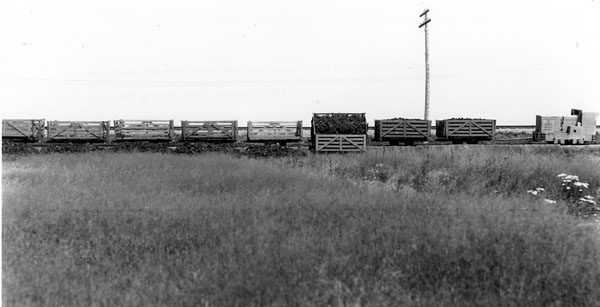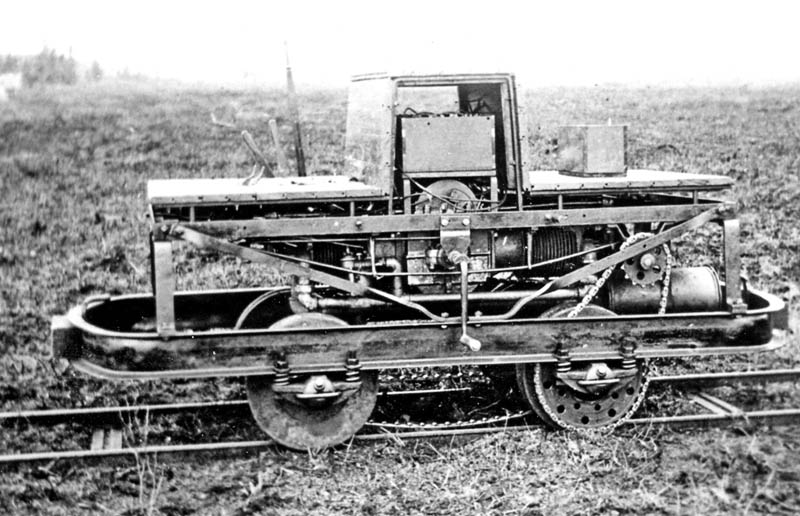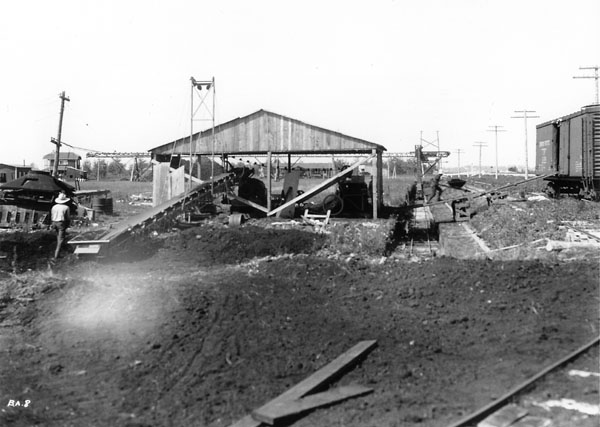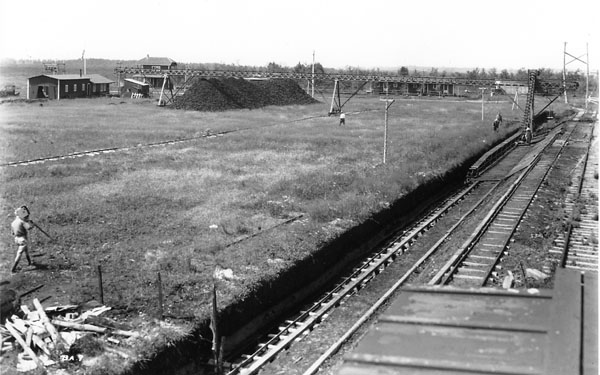
While looking at my data base of industrial locomotives recently I came across an intriguing reference to a small 24" gauge locomotive built by the Fate Root Heath Company of Plymouth, Ohio. It was delivered to O'Brien Munitions in Renfrew, Ontario, in June 1916 to help in the war effort. However, the record showed that this "critter" moved in March 1920 to the Government Peat Committee in Alfred, Ontario. Alfred station was at mile 46.1, near Caledonia Springs, on the now abandoned M&O subdivision and the Dominion Peat Company siding is shown at mile 45.06 in Employee Timetables of the period (Mile 0.00 was at Vaudreuil). Duncan duFresne remembers coming through Alfred on CPR steam locomotives in the early 1950's and it would amaze him that he would running hard on a Royal Hudson with a clear stack, yet visibility of the way ahead would be impaired by dense smoke from the burning peat. This is the story of the Alfred Peat Bog Railway. In 1906 the Department of Mines in Ottawa became interested in the possibility of using peat bogs as a source of fuel. Many parts of the country, including the Ottawa area, were a long way from coal mines and so an investigation was made of many of the peat bogs in the country. The surveys, many of them carried out by Mr. Aleph von Anrep of the Department, soon indicated that there were vast resources of potential energy and the project soon developed into a second phase. Mr. Anrep developed a process for air drying and treating peat for fuel purposes and it was decided to carry out a pilot project at the Alfred Peat Bog. In 1909 the Department acquired 300 acres of peat bog with an average depth of 8 feet. Five miles of ditches were dug and a storage shed was erected with a capacity of 300 tons of dried peat. A blacksmiths shop and office were also provided. An "Anrep" peat excavating machine and conveyor were installed with a capacity of 25-30 tons of peat per day. A circular field track of 600 mm. gauge was installed and eight steel dumping cars of 0.7 ton capacity were acquired. Haulage was by means of a 1,200 foot long steel cable. Full operation commenced
in 1910. A 500 foot siding was laid in from the CPR main line
in that year and full operations were carried on from the middle
of May until the middle of October. By the end of the 1911
season the Department felt that the demonstration was successful
so that a company organized by a Mr. Shuttleworth took over the
operation and substituted some machinery for some of the more labour
intensive aspects. Full commercial operation started in 1913 but
this failed almost immediately and the operation was dormant during the
first world war.
The Department of Mines
became involved once again in 1918 when a Peat Committee was formed
with joint input from the federal and provincial governments.
Two miles of narrow gauge track, including switches, were obtained
along with a gasoline locomotive and 16 cars. A loading trestle
was installed close to the CPR siding which was renovated. The
cost of the transport acquisitions and renovations was $13,000.
During 1919, two types of harvesting machine were tested, the Anrep and the Moore system. Both had difficulty with the caterpillar tracks which were used to move them over the bog and there was also a problem in obtaining boilers to produce the steam which powered them. In the end locomotive type boilers had to be used but these had to burn coal because the fire grates were not large enough to burn peat. A second train of harvesting cars, complete with gasoline locomotive, was ordered in 1920. This second locomotive was the Plymouth which came from O'Brien Munitions in March 1920, the locomotive which set off my inquiries in the first place! However there were some difficulties with the additional cars. On 2 February 1920 an order was placed with Hammant Steel Car and Engineering of Hamilton for four side dump, V shaped, cars for the Anrep Spreading System. $152 per car. "Cars to have Hyatt steel roller bearings and cast steel double flanged wheels, patterns for which will be forwarded from William Hamilton Company of Peterborough. These cars to be shipped from Hamilton to the Peat Committee at Alfred, Ontario not later than March 15th". Unfortunately Hammant was beset with a large number of orders and the cars were not billed until 28 July 1920. This was too late for the 1920 season and the consignment was refused and languished for some time in the CPR freight shed at Alfred. The double flanged wheels, which were used on the hopper cars which brought the peat from the field to the central drying area. The double flanges might have helped the cars stay on the indifferent track which presumably had no switches. A different type of side unloading open car was used to move the product around the plant and through weigh scales. The plant also had a turntable at this time. The Peat Committee was disbanded on 1924 and all machinery was transferred to Peat Fuels Ltd. in April 1923. Peat manufacturing terminated in the autumn of 1928 but some peat was shipped out during 1929. The plant was closed indefinitely in 1929 and there the matter seems to have ended although there was an attempt to revive this in 1940. I only have details of one locomotive coming to Alfred although the records indicate that two were used. The second one to arrive, in March 1920, was Plymouth serial number 123, model AL-2, 24" gauge delivered new to O'Brien Munitions in June 1916. The first machine remains a mystery although O'Brien Munitions had another Plymouth, serial 74 of December 1915, a 24" gauge model AL-1. I do not have a disposition on this locomotive so it may have been the locomotive that went to Alfred in 1919 - I should caution that this is speculation and I would appreciate any additional information. Similarly I have no disposition on either of the locomotives. They may have languished until the early 1940's and then were cut up as part of the war effort. The project seems to have been doomed because peat has a low calorific content compared with coal and only a thousand tons or so a year was ever shipped out, mainly to Ottawa. Another disadvantage was the short season which was predicated by our severe winters. Luckily there are a
number of excellent photographs in the National Archives of Canada
which illustrate the entire process. I hope you enjoy this
record of an interesting, if short lived, railway system which was
vastly different from the CPR Royal Hudsons and other locomotives which
swept past so close by.
Sources:
(1) National Library, Sessional Papers
of the Department of Mines 1909-1925, Annual
Reports of the Department of Mines 1925-1940.  Peat Bog
Locomotives
In the May,
2000 Branchline I wrote about the
Alfred Peat Bog Railway which was adjacent to the Canadian Pacific
M&O
subdivision, east of Ottawa. I have just
received additional information including two photos found
in the Royal Swedish Archives (Riksarkivet). The
photos were glued into a Canadian travel report issued by Sveriges
Torvingenjörer (the Swedish Peat Engineers), an organization that
conducted
several field trips in the early 1900s.
 The caption for the locomotive and train reads "Alfred Bog" while the caption for the locomotive on its own reads "Moose's Small Gasoline Transportation Engine"  These are very simple machines with a chain drive. That shown with a train of four wheel hoppers is presumably taken at Alfred and could well have been before the arrival of the For this information I am indebted to Jan Ericson who wrote to me, and to his friend Bo Gyllenberg who found the photographs. Bytown Railway
Society, Branchline, December 2008.
|
Home Articles




